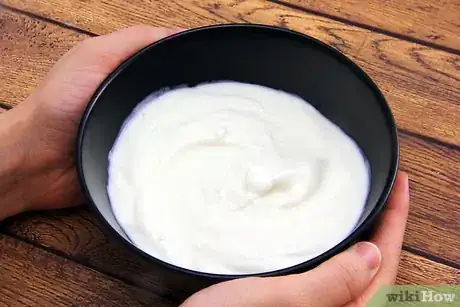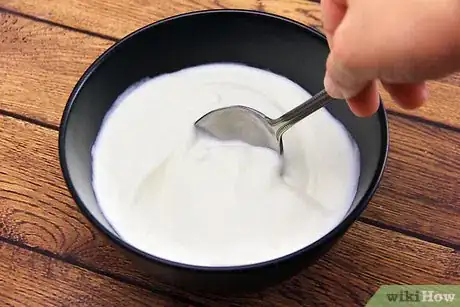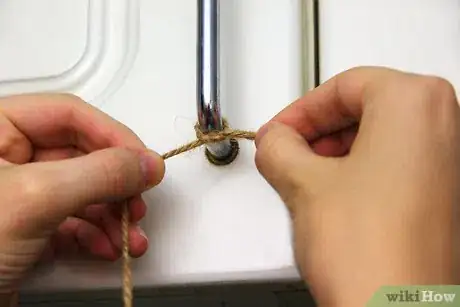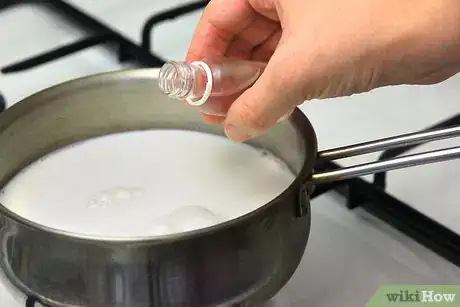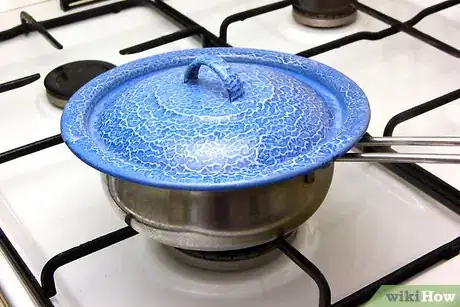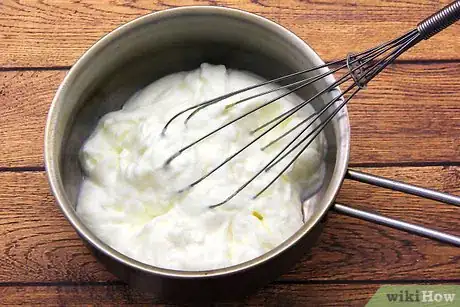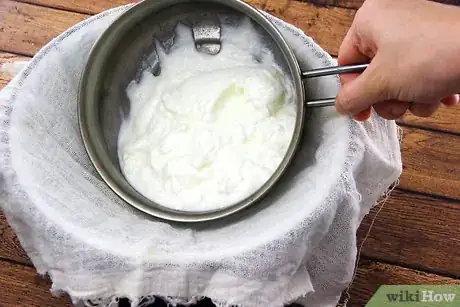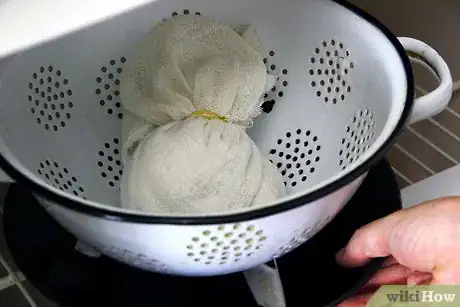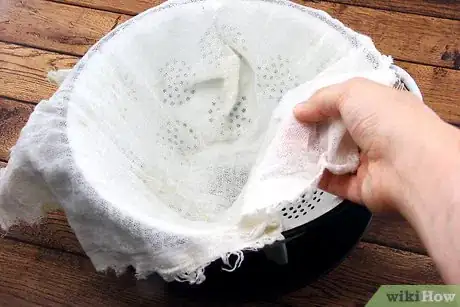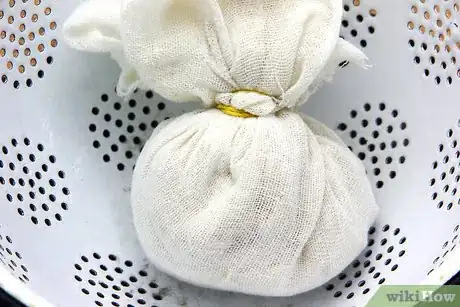This article was co-authored by wikiHow Staff. Our trained team of editors and researchers validate articles for accuracy and comprehensiveness. wikiHow's Content Management Team carefully monitors the work from our editorial staff to ensure that each article is backed by trusted research and meets our high quality standards.
This article has been viewed 55,683 times.
Learn more...
Cream cheese is a great place to start for beginner cheese makers. It requires very few ingredients and very little effort. In fact, it's so easy you'll wonder why you didn't make your own cream cheese sooner! To begin your journey as a cheese maker, follow the steps below.
Ingredients
- 32 fluid ounces light cream or half and half
- 1 package (1/8 teaspoon) mesophilic starter culture
- Sea salt, to taste
- 32 fluid ounces whole milk
- 48 fluid ounces heavy whipping cream (at least 35% fat content)
- 2 fluid ounces buttermilk
- 2-3 droplets of liquid veal rennet
- 1 tablespoon of salt
- 32 fluid ounces plain yogurt (whole milk or low fat)
Steps
Easy Cream Cheese
-
1Bring the cream (or half and half) to room temperature. You may need to leave it out of the fridge for a couple of hours. Once it has reached room temperature, pour the cream into a large bowl.
-
2Add the mesophilic starter. Sprinkle the mesophilic starter into the cream and stir thoroughly to combine. Cover the bowl with a clean dishcloth or some plastic wrap and leave to sit at room temperature for about 12 hours.
- A solid curd will form, resembling the texture of firm yogurt.
- Room temperature is considered to be about 72°F. If your house is any cooler, the cream cheese mixture will take slightly longer to set.[1]
Advertisement -
3Drain the curds. Line a colander with a butter muslin cloth. Then pour the cream cheese mixture into the muslin-lined colander. Gather the corners of the muslin cloth and tie to form a bag. Use some string to hang the bag from the handle of a kitchen cupboard. Place a bowl underneath the bag to catch the whey.
- If you do not have suitable cupboard handles to to hang the bag from, try tying the bag around the handle of a wooden spoon and balance the spoon over a jug or bowl.
-
4Let the bag drain for up to 12 hours. The length of time you allow the bag to drain will determine the consistency of your cream cheese. A shorter draining time will result in a softer cheese, while a longer draining time will result in a firmer cheese. Find the consistency that works for you - there is no right or wrong, just personal preference.
- Use a shorter draining period to produce a soft cream cheese that works well in spreads and dips, or use a longer draining period to produce a firm cream cheese more suited for baking or cooking.[1]
- Once the cream cheese is finished, you can chill it in the refrigerator, which will also lend it a firmer consistency.
-
5Add salt or flavorings. After the cream cheese has finished draining, remove it from the muslin bag and place it in a bowl. Add a teaspoon of sea salt, if desired. At this point you can also add in the flavor of your choice. Here are some ideas:
- Onions and chives.
- Toasted nuts and honey.
- Cinnamon and brown sugar.
- Homemade jams and preserves; strawberry, apricot etc.
- Rosemary and garlic.
- Bacon bits or chopped ham.
-
6Store your cream cheese. Store your cream cheese in a sealed plastic container in the fridge. It should keep for up to two weeks.[1]
Buttermilk-Based Cream Cheese
-
1Heat the milk and cream. Add the milk and the cream to a large, nonreactive pot and warm over a low heat until the temperature reaches 70°F (~21°C).
- Do not allow the milk and cream to boil.
- Use an instant read thermometer to get an exact temperature read.
-
2Stir in the buttermilk and rennet. Add the buttermilk to the milk and cream mixture and stir to combine. Then add the veal rennet.
-
3Leave overnight. Cover the pot with a lid and leave the cream cheese mixture overnight, at room temperature. The next day, the mixture will have set.
-
4Add the salt. Sprinkle the salt all over the surface of the set mixture.
-
5Cut into curds. Using a large wire whisk, cut the gelled cream cheese mixture into small curds.
-
6Drain the mixture. Line a large colander with a butter muslin cloth. Place the colander in a bowl large enough to hold the whey. Gently pour the cream cheese mixture into the colander and let it drain for about 30 minutes.
-
7Remove the whey. Gather the corners of the muslin cloth and tie them together with a rubber band to form a bag. Empty out the whey that has collected in the bowl.
-
8Refrigerate. Place the cloth bag containing the cheese back in the colander, and put the colander back in the bowl. Put the whole thing in the refrigerator and let the curds continue to drain overnight.
-
9The cream cheese is ready to use the next day. Use immediately or store in a plastic container in the fridge for up to two weeks.
Yogurt-Based Cream Cheese
-
1Line a colander with a clean butter muslin cloth. Place the colander in a bowl that is large enough to hold it.
-
2Add the yogurt. Pour the plain yogurt into to the lined colander. Gather the corners of the muslin cloth and tie with a rubber band to form a bag.
-
3Leave to drain. Leave the yogurt to drain for about 5 hours in the refrigerator. If you want a thicker consistency, leave it for longer.
-
4Store your finished cream cheese in a resealable container in the fridge. Better yet, use an old packaged cream cheese container to do the job!
Warnings
- Keep a careful watch on your temperature readings. Temperatures too hot or too cold may ruin your cheese.⧼thumbs_response⧽
- Cleanliness is of the utmost importance in cheese-making. Equipment must be thoroughly cleaned before and after making cheese. Choose glass, stainless-steel, or food grade plastic that can be sterilized. To sterilize your milk heating pan, fill it with about two inches of water, put a lid on it and boil for 10 minutes. Make sure all utensils that come in contact with milk are first rinsed in cold water and then washed in hot water. This prevents milk stone.⧼thumbs_response⧽
Things You'll Need
- Measuring cups (glass is preferred) and spoons (stainless steel).
- Large, nonreactive pot, e.g. stainless steel. Avoid copper and aluminium pots.
- A colander.
- A large bowl.
- An instant read thermometer.
- A muslin cloth. (A cheesecloth or bleached pillowcase will also work).
- String
References
- ↑ 1.01.11.2http://chickensintheroad.com/cooking/homemade-cream-cheese-so-easy-a-child-could-make-it/
- http://shesimmers.com/2010/12/how-to-make-cream-cheese-at-home.html
- http://www.theprairiehomestead.com/2012/10/how-to-make-cream-cheese.html
- http://www.motherearthnews.com/real-food/how-to-make-sour-cream-and-cream-cheese-recipes.aspx#axzz2XGi4YBYi
- http://www.culturesforhealth.com/how-to-make-cream-cheese-recipe
About This Article
To make cream cheese, pour room temperature cream into a large bowl and stir in a packet of mesophilic starter. Next, cover with plastic wrap and let it sit for around 12 hours, until a solid curd forms. To drain the liquid whey, line a colander with muslin cloth, pour your curds and whey over the cloth, and tie the ends together to form a bag. Then, use string to suspend the bag over a large bowl to catch any remaining liquid. Finally, after draining for 12 hours, season to taste and refrigerate. To learn a variation on this recipe using buttermilk and rennet, scroll down!
